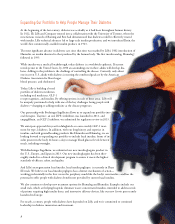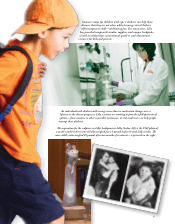Eli Lilly 2013 Annual Report Download - page 20
Download and view the complete annual report
Please find page 20 of the 2013 Eli Lilly annual report below. You can navigate through the pages in the report by either clicking on the pages listed below, or by using the keyword search tool below to find specific information within the annual report.
6
MCOs typically maintain formularies specifying which drugs are covered under their plans. Exclusion of a
drug from a formulary can lead to its sharply reduced usage in the MCO patient population. Consequently,
pharmaceutical companies compete aggressively to have their products included. Where possible, companies
compete for inclusion based upon unique features of their products, such as greater efficacy, fewer side
effects, or greater patient ease of use. A lower overall cost of therapy is also an important factor. Products that
demonstrate fewer therapeutic advantages must compete for inclusion based primarily on price. We have
been generally, although not always, successful in having our major products included on MCO formularies.
Patents, Trademarks, and Other Intellectual Property Rights
Overview
Intellectual property protection is critical to our ability to successfully commercialize our life sciences
innovations and invest in the search for new medicines. We own, have applied for, or are licensed under, a
large number of patents in the U.S. and many other countries relating to products, product uses, formulations,
and manufacturing processes. In addition, as discussed below, for some products we have additional effective
intellectual property protection in the form of data protection under pharmaceutical regulatory laws.
The patent protection anticipated to be of most relevance to human pharmaceuticals is provided by national
patents claiming the active ingredient (the compound patent), particularly those in major markets such as the
U.S., various European countries, and Japan. These patents may be issued based upon the filing of
international patent applications, usually filed under the Patent Cooperation Treaty (PCT). Patent applications
covering the compounds are generally filed during the Discovery Research Phase of the drug discovery
process, which is described in the “Research and Development” section of “Business.” In general, national
patents in each relevant country are available for a period of 20 years from the filing date of the PCT
application, which is often years prior to the launch of a commercial product. Further patent term adjustments
and restorations may extend the original patent term:
• Patent term adjustment is a statutory right available to all U.S. patent applicants to provide relief in
the event that a patent is delayed during examination by the U.S. Patent and Trademark Office.
• Patent term restoration is a statutory right provided to U.S. patents that claim inventions subject to
review by the U.S. Food and Drug Administration (FDA). A single patent for a human pharmaceutical
product may be eligible for patent term restoration to make up for a portion of the time invested in
clinical trials and the FDA review process. Patent term restoration is limited by a formula and cannot
be calculated until product approval due to uncertainty about the duration of clinical trials and the time
it takes the FDA to review an application. There is a five-year cap on any restoration, and no patent
may be extended for more than 14 years beyond FDA approval. Some countries outside the U.S. also
offer forms of patent term restoration. For example, Supplementary Protection Certificates are
sometimes available to extend the life of a European patent up to an additional five years. Similarly,
in Japan, Korea, and Australia, patent terms can be extended up to five years, depending on the
length of regulatory review and other factors.
Loss of effective patent protection for human pharmaceuticals typically results in the loss of effective market
exclusivity for the product, which can result in severe and rapid decline in sales of the product. However, in
some cases the innovator company may be protected from approval of generic or other follow-on versions of
a new medicine beyond the expiration of the compound patent through manufacturing trade secrets, later-
expiring patents on methods of use or formulations, or data protection that may be available under
pharmaceutical regulatory laws. The primary forms of data protection are as follows:
• Regulatory authorities in major markets generally grant data package protection for a period of years
following new drug approvals in recognition of the substantial investment required to complete clinical
trials. Data package protection prohibits other manufacturers from submitting regulatory applications
for marketing approval based on the innovator company’s regulatory submission data for the drug.
The base period of data package protection is five years in the U.S. (12 years for new biologics as
described below), ten years in the EU, and eight years in Japan. The period begins on the date of
product approval and runs concurrently with the patent term for any relevant patent.
• Under the Biologics Price Competition and Innovation Act (enacted in the U.S. in 2010), the FDA has
the authority to approve similar versions (biosimilars) of innovative biologics. A competitor seeking
























